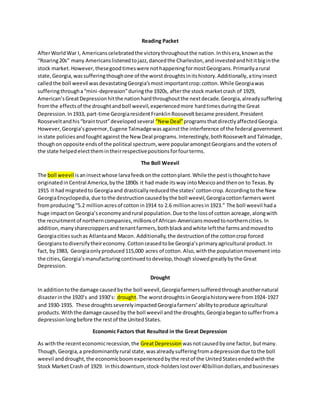
Post World I
- 1. Reading Packet AfterWorldWar I, Americanscelebratedthe victorythroughoutthe nation.Inthisera,knownasthe “Roaring20s” many Americanslistenedtojazz,dancedthe Charleston,andinvestedandhititbiginthe stock market.However,thesegoodtimeswere nothappeningformostGeorgians.Primarilyarural state,Georgia,wassufferingthoughone of the worstdroughtsinitshistory.Additionally,atinyinsect calledthe boll weevil wasdevastatingGeorgia’smostimportantcrop:cotton.While Georgiawas sufferingthrougha“mini-depression”duringthe 1920s, afterthe stock marketcrash of 1929, American’sGreatDepressionhitthe nationhardthroughoutthe nextdecade.Georgia,alreadysuffering fromthe effectsof the droughtandboll weevil,experiencedmore hardtimesduringthe Great Depression.In1933, part-time GeorgiaresidentFranklinRooseveltbecame president.President Rooseveltandhis“braintrust”developedseveral “New Deal”programsthatdirectlyaffectedGeorgia. However,Georgia’sgovernor,Eugene Talmadgewasagainstthe interference of the federal government instate policiesandfoughtagainstthe New Deal programs.Interestingly,bothRooseveltandTalmadge, thoughon opposite endsof the political spectrum, were popularamongstGeorgians andthe votersof the state helpedelectthemintheirrespectivepositionsforfourterms. The Boll Weevil The boll weevil isaninsectwhose larvafeedsonthe cottonplant.While the pestisthoughttohave originatedinCentral America,bythe 1890s it had made itsway intoMexicoandthenon to Texas.By 1915 it hadmigratedto Georgiaand drasticallyreducedthe states’cottoncrop.Accordingtothe New GeorgiaEncyclopedia,due tothe destructioncausedbythe boll weevil,Georgiacottonfarmerswent fromproducing“5.2 millionacresof cottonin1914 to 2.6 millionacresin1923.” The boll weevil hada huge impacton Georgia’seconomyandrural population.Due tothe lossof cotton acreage,alongwith the recruitmentof northerncompanies,millionsof African-Americansmovedtonortherncities.In addition,manysharecroppersandtenantfarmers,bothblackandwhite leftthe farmsandmovedto Georgiacitiessuchas Atlantaand Macon. Additionally,the destructionof the cottoncrop forced Georgianstodiversifytheireconomy.Cottonceasedtobe Georgia’sprimaryagricultural product.In fact, by1983, Georgiaonlyproduced115,000 acres of cotton.Also,withthe populationmovementinto the cities,Georgia’smanufacturingcontinuedtodevelop,though slowedgreatlybythe Great Depression. Drought In additiontothe damage causedbythe boll weevil,Georgiafarmerssufferedthroughanothernatural disasterinthe 1920’s and 1930’s: drought.The worstdroughtsinGeorgiahistorywere from1924-1927 and 1930-1935. These droughtsseverelyimpactedGeorgiafarmers’abilitytoproduce agricultural products.Withthe damage causedby the boll weevil andthe droughts,Georgiabegantosufferfroma depressionlongbefore the restof the UnitedStates. Economic Factors that Resulted in the Great Depression As withthe recenteconomicrecession,the GreatDepression wasnotcausedbyone factor, butmany. Though,Georgia,a predominantlyrural state,wasalreadysufferingfromadepressiondue tothe boll weevil anddrought,the economicboomexperiencedbythe restof the UnitedStatesendedwiththe Stock MarketCrash of 1929. Inthisdownturn,stock-holderslostover40billiondollars,andbusinesses
- 2. were neverable torecoverfromthese lossesthroughoutthe 1930s. However,aseriesof otherfactors ledto the continuationof aworld-widedepressionforalmostadecade.Some of the othereconomic factors thatledto the Great Depressionwere:BankFailures:Duringthe 1920s and 1930s there wasno insurance protectingdeposits.If enoughof the bankscustomerstriedtowithdraw theirmoney,the bankwouldeventuallyrunout.Thiswascalleda bankfailure.Afterthe stockmarketcrashthisactually happenedandmanybanksfailedinthe early1930s. In turn manypeople losttheirlifesavings.Those banksthat managedto stayin businesswere hesitantaboutmakingloans,thusslowingdownthe purchasingpowerof bigbusinessandthe individual buyer.ReductioninPurchasing:Inwhatbecame a viciouscycle,afterthe stockmarketcrash, anddue to othereconomicfears,the average consumer stoppedpurchasinggoods.Whenpeople stoppedbuyingproducts,companiesinturnloweredtheir productionrates.Withlowerproductionrates,manyconsumerslosttheirjobsand hadno moneyto spend.Withan unemploymentrate of 25%, thisfurtherlessenedthe purchasingpowerof the average consumer.Overproductionof AgricultureProducts:Before the majordroughtsthathitthe Midwest causingthe Dust Bowl,manyfarmersover-produced.Inthe 1920s Midwesternfarmersproducedrecord numbersof agricultural products.However,thisover-productionledtoatremendousdropinthe price of agricultural productsanddramaticallylimitedthe profitmarginsof farmers.Duringaperiodof time where millionswerestarving,farmersdestroyedmuchneededfoodorstoppedgrowingcropsall togetherinorderattemptto raise the price of agricultural products.A major droughthitthe Midwestin the 1930s drivingthousandsof farmersfromtheir homesandaddedtothe millionsof Americans alreadyoutof work. Eugene Talmadge In hisgubernatorial electioncampaignsof the 1930’s Eugene Talmadge,wearingredsuspendersand roundedglasses,promisedGeorgia’srural votersthattheyhadthree friendsinthe world“the Sears RoebuckCompany,Godalmighty,andEugene HermanTalmadge of SugarHill,Georgia.”Though extremelypopularinGeorgia,historiansdebatewhetherhispoliciesasgovernordidmore harmthan goodfor a state ravagedbythe Depression.Eugene Talmadge(1884-1946) was born inForsythCounty, Georgiaon hisparents’farm.He attendedthe Universityof Georgiaandearnedalaw degree in1907. In 1920 and 1922 he unsuccessfullycampaignedforthe GeorgiaGeneral Assembly.However,in1926, he wonhisfirstelectionasCommissionerof Agriculture,apositionhe helduntil 1930. Inhisrole as Agriculture Commissionerhe wasable to cementhisstandingwithrural Georgiavotersbypresenting himself asanadvocate for the farmerand common man inthe Departmentof Agriculture’swidelyread newspapercalledthe MarketBulletin.Thoughinvolvedinapolitical scandal concerningthe misappropriationof fundsinthe early1930s, he ran for the office of governorin1932. Due to hisrural supportand the powerof the county unitsystem, he waselectedin1932 and again in1934. Inhis campaign,Talmadge promisedGeorgiavotershe wouldbalance the state’sbudget,lowerthe utility rate,reduce the price of auto tags,and reorganize the state highwayboard.Talmadge liveduptohis promises,thoughhismeanswere questionable.Accordingtothe New GeorgiaEncyclopedia“Whenthe legislaturerefusedtolowerthe price of automobile tagshe didsoby executiveorder.Whenthe Public Service Commission, abodyelectedbythe voters,refusedtolowerutilityrates,he appointedanew board to getit done.Whenthe highwayboardresistedhiseffortstocontrol it,he declaredmartial law and appointedmore cooperative memberstothe board.”Talmadge alsomade decisionsthathurtthe state.He foughtagainstRoosevelt’sNewDeal policies,especiallythosethataidedAfrican-Americans, and opposedRoosevelt’sre-nominationin1936. Due to a GeorgiaConstitutional Amendmentbarring
- 3. Talmadge frombeingreelectedin1936, he made twounsuccessful campaignsforthe U.S.Senate. However,in1940, he was reelectedandmade adecisionthatgreatlydamagedtothe state’suniversity system.Hissuccessinforcingthe UniversitySystemBoardof Regentstoremove twofacultymembersof the Universityof Georgiafor“underminingthe state’sracial statusquo”(supportingintegration) ledto the SouthernAssociationof College andSchoolstoremove the state’saccreditationof all whitecolleges. Thisledto Talmadge’sdefeatinthe nextgubernatorial election.Talmadge wasdownbutnotout.In the 1946 election,rural GeorgianshelpedtoreelectTalmadge,whowasrunningona segregationist platform,fora fourthterm.However,Talmadge diedbefore takingoffice.AfterTalmadge’sdeath,the GeorgiaGeneral AssemblyselectedhissonHermanasgovernor,thoughhe hadnot run forgovernorin the election. The New Deal ThoughGeorgiavoterssupportedGovernorEugene Talmadge,acriticof the New Deal,inseveral electionsGeorgiansalsooverwhelminglysupportedPresidentFranklinRooseveltandhisNew Deal programsthroughoutthe Great Depression.The New Deal Programsprovidedaidandsupporttomany poor Georgians.Thoughthese programsdidnotendthe Great Depression,theyhelpedmanypoor Georgianscope duringthe difficulteconomictimes. The Civilian Conservation Corps One of the NewDeal programsthat had a major impacton the state was the CivilianConservation Corps(CCC).The purpose of the program was to hire unemployedyoungmentoworkon publicservice projects.Some of these projectsincludederosioncontrol,floodprevention,andpublicparks.Menwho volunteeredforthisservice signedsix monthcontractsandwere providedroomandboard.In addition, theyalsoreceived$30 a month,$25 of whichhad to be sentback to theirfamilies.Of all of the New Deal programsthiswas probablythe mostsuccessful andpopular.Overthe nine yearsitwasin existence,over3millionyoungmenworkedinthe programandplanted millionsof tree throughoutthe country.However,once the U.S.enteredWorldWar II,these menchangedoutof theirCCC uniforms and intomilitaryones.In1942 the CCC was disbanded.InGeorgiathe CCChada lastingimpact. Accordingto the NewGeorgiaEncyclopediaover“78,000 Georgianswere employedbythe CCC”and these menplantedover22 milliontreesandbuiltorimprovedseveral state parks.These parksare still usedtoday,includinghistoricbattle fieldssuchasChickamaugaand Kennesaw Mountain,and“forest parks” suchas A.H. StephensandHardLabor Creek. Rural Electrification It is oftensaidthatwhile Rooseveltwasstayingathishome “the Little White House”inWarmSprings, GA, he was shockedatthe costof hiselectricbill.According tothe story,Rooseveltclaimedthathe paid lessat hislarge home inNewYork thanhe didforhis small home inGeorgia.Whetherthisstoryistrue or not, Roosevelthadaninterestinbringingelectricitytoall partsof the country.In 1935 the Rural ElectricAdministrationwasestablishedtodojustthat.Though manymembersof Congressandstate governors,suchas Talmadge,foughtagainstthisprogram, fearingitwouldleadtosocialism, many farmersbenefitedfromit.Accordingtothe New Deal Network,by1939 there wasa 25% increase inthe numberof rural householdsthathadelectricity,andfora reasonable price.If theycouldaffordit,many farmersboughtappliancesthatusedelectricitywhichhelpedstimulate the economy.Since Georgiawas a rural state duringthistime period,manyGeorgiansalsobenefitedfromthe program.
- 4. The AAA/Social Security Two additional NewDeal programshadalastingeffectonGeorgians.The firstwasthe Agricultural AdjustmentAct(AAA).The basicpremise of the AAA wasthatsince somany farmerscontinuedtogrow crops such as cottonand tobacco duringthe Depression,drivingthe pricesof these productsdown,the federal governmentofferedtopayfarmersnot to grow those crops.This causedthe price of agriculture productsto rise whichhelpedfamersmake more moneyandeliminate surplusproduction. Yet, inmanycases,this policydidmore harmthan goodfor sharecroppersandtenantfarmers.Though the governmenttoldthe landownerthatthe paymentsshouldbe distributedtothose wholivedand workedthe land,manylandownerssimplykeptthe moneyforthemselves.The governmentcouldnot enforce thisrule and,as a result,manyof the people whoneededthisaidneverreceivedit.Often,since the sharecropperor tenantfarmercouldnotwork the land,theywere simplyremoved.Thiswasone of the factors that ledtourbanizationandthe endof sharecroppingandtenantfarminginthe state. The lastprogram that hada lastingeffectonGeorgiawasthe Social SecurityAdministration(SSA).Until 1935, those whowere toooldor unable towork were dependentonthe charityof others.The Social SecurityAdministrationoffersbenefitsforthose over65, those whoare disabled,orthose whoare the survivorsof a beneficiarywhohasdied.Thisprogramisone of the longestrunningof the New Deal,and todaymost Georgiansare connectedtothe SSA eitherthroughpayingsocial securitytaxesorreceiving social securitybenefits.